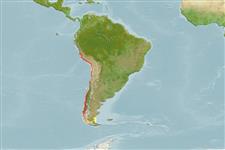Common names from other countries
Classification / Names / Names
ชื่อสามัญ | ชื่อพ้อง | Catalog of Fishes (gen., sp.) | ITIS | CoL | WoRMS
Environment: milieu / climate zone / depth range / distribution range
นิเวศวิทยา
; ระดับความลึก 10 - 1138 m (Ref. 87391). Temperate; 11°S - 54°S, 78°W - 68°W
Southeast Pacific and Southwest Atlantic: Chile and Peru.
Length at first maturity / ขนาด / น้ำหนัก / Age
Maturity: Lm ? range ? - ? cm Max length : 15.0 cm CW เพศผู้/กระเทย; (Ref. 78814); 11 cm CW (female)
Found on soft-bottom sublittoral habitats. Mainly epifaunal but can be considered a bioturbator as it reworks sediments. Notably disturbs the sea floor, exhibiting "sediment mining" behavior while in search of prey. Predatory (Ref. 106462).
Life cycle and mating behavior
วัยเจริญพันธุ์ | การสืบพันธุ์ | การวางไข่ | เซลสืบพันธ์ของเพศเมีย(ไข่) | ความดกของไข่ | ตัวอ่อน
Members of the order Decapoda are mostly gonochoric. Mating behavior: Precopulatory courtship ritual is common (through olfactory and tactile cues); usually indirect sperm transfer.
Gorny, M. 1999. (Ref. 87391)
IUCN Red List Status (Ref. 130435)
CITES status (Ref. 108899)
Not Evaluated
Not Evaluated
Threat to humans
Harmless
Human uses
การประมง: การค้า
FAO - การประมง: landings | FishSource | ทะเลรอบๆเรา
เครื่องมือ
ข้อมูลเพิ่มเติม
Age/SizeการเจริญเติบโตLength-weightLength-lengthสัณฐานวิทยาตัวอ่อนอุดมสมบรูณ์
แหล่งที่มาจากอินเตอร์เน็ต
Estimates based on models
Preferred temperature
(Ref.
115969): 6.5 - 12.3, mean 9.4 (based on 36 cells).
